Performance art: a new Alexander Calder retrospective opens at Tate Modern

As Achim Borchardt-Hume, director of exhibitions at Tate Modern, points out, an Alexander Calder mobile has long been an almost essential fitting for the modernist dream home; in renders as much as the realised, where they are instantly recognisable, and bring colour and movement to hypothetically elegant, airy spaces. Architects love Calder as he loved them (he knew all the important ones) because he created wonderful objects that move in space and make spaces feel more wonderful. (His mobiles are also as much about what isn’t there – their transparency and fluttering lightness – which also appeals to modernist architects.)
Of course, its not just architects. Everyone loves a Calder. The Calder mobile is the friendly, accessible, unpretentious and playful face of modernism. There is nothing difficult about a Calder. And, as happens, Calder’s reputation has suffered from this warm over familiarity.
'Alexander Calder: Performing Sculpture', a new show at Tate Modern and the largest ever UK show of Calder’s works, reminds us how serious Calder was about his art. And how, as it evolved over time, much Calder removed to get what he wanted.
Sandy Rower, Calder’s grandson and president of the Calder Foundation, was in London for the opening of the show – and was quick to point out that this wasn’t a simple retrospective. The show starts with Calder’s early output from his time in 1920s Paris and finishes with works from the early 1950s. Calder carried on working, and at a good pace, for almost three decades, during which his work got bigger and more ambitious (the Tate Modern show doesn’t include any of the more monumental stabiles that architects loved to put in their modernist plazas). But it was in these three decades that Calder got the essentials right.
The show begins with his wire sculptures, clever 3-D sketches including one of Josephine Baker and others of the circus performers and acrobats who were a continuing fascination to the artist.
By the 1930s, and following a career-changing visit to the studio of Piet Mondrian – 'it was like a baby being slapped to make its lungs stop working,' Calder said – he had moved on to mechanised ‘mobiles’, a term coined by his friend Marcel Duchamp. (When A Universe, amongst the best known of these motorised pieces, was first exhibited at MoMA, Einstein apparently spent forty minutes watching it complete its full cycle of movements).
Later in the decade he would lose the motors and relay on precise balance and air flow to create movement. These fluid abstracts, constantly shifting and ‘performing’, were a radical break from the past, taking sculpture to entirely new places – Calder was from a long line of figurative sculptures so he knew where he was heading away from. These pieces – Morning Star, Constellation, Vertical Foliage, Gamma, Snow Flurry are all on show – are cosmic systems or natural events. 'The idea of detached bodies floating in space, of different sizes and densities, some at rest, while others move in particular manners, seems to me the ideal source of form,' Calder said.
The show ends with Black Widow, a 3.5m mobile donated to the Institute of Architects of Brazil in São Paulo in 1948, while Calder was travelling and exhibiting in Brazil.
Calder’s influence on young Brazilian artists of the time, such as Lygia Clark and Hélio Oiticica, is obvious. And Calder remains an influence. Witness Sarah Sze’s marvelous mobiles, shown at Victoria Miro this year. Sze is just one the artists to enjoy a residency at the Atelier Calder, built by Calder near Saché in France in 1962. Run by Rower and the Calder Foundation. It offers artists the chance to work in what was Calder’s huge, light-filled studio, live in the Calder residence and enjoy the views across the Loire Valley.
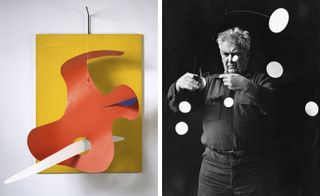
The show is titled ’Alexander Calder: Performing Sculpture’ and is the largest ever UK show of Calder’s works. Left: Form Against Yellow (Yellow Panel), 1936. Right: Alexander Calder with Snow Flurry I (1948), 1952.

The show starts with Calder’s early output from his time in 1920s Paris and finishes with works from the early 1950s. Pictured: Black Frame, 1934.

Installation shot of Calder’s mobiles and stabiles Courtesy: Calder Foundation, New York / DACS, London
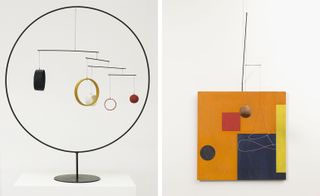
Left: Untitled, c.1934. Right: Untitled, c.1937.

The show begins with his wire sculptures, clever 3-D sketches including one of Josephine Baker and others of the circus performers and acrobats who were a continuing fascination to the artist. Pictured left: Two Acrobats, 1929. Courtesy Menil Collection. Right: Small Sphere and Heavy Sphere, 1932–33.
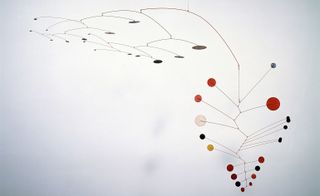
Everyone loves a Calder. The Calder mobile is the friendly, accessible, unpretentious and playful face of modernism. Pictured: Gamma, 1947.
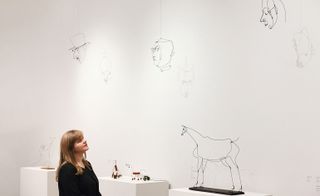
Installation shots of Calder’s wire portraits (Joan Miró, 1929, Fernand Léger, 1930, and Varése, c.1930). Courtesy: Calder Foundation, New York / DACS, London
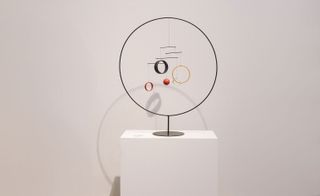
Installation shot of Untitled, c.1934 Courtesy: Calder Foundation, New York / DACS, London
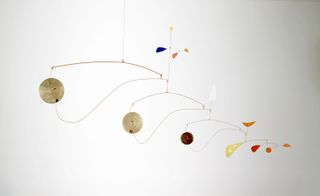
Later in his career, Calder would relay on precise balance and air flow to create movement. Pictured: Triple Gong, c.1948.

Vertical Foliage, 1941.
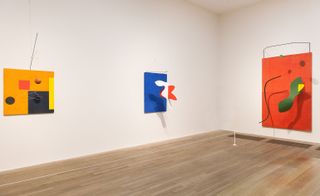
Installation shot of Calder’s panel works, which have been reunited for the first time (pictured here is Blue Panel, 1936) Courtesy: Calder Foundation, New York / DACS, London

There is nothing difficult about a Calder. And, as happens, Calder’s reputation has suffered from this warm over familiarity. Pictured left: Red and Yellow Vane, 1934. Right: Fernand Léger, c.1930. Private collection

Installation shot of Black Widow, c.1948. Courtesy: Calder Foundation, New York / DACS, London
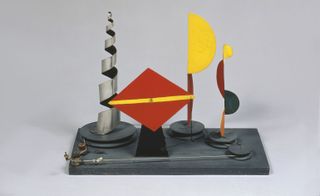
Untitled maquette for 1939 New York World’s Fair, 1938
INFORMATION
’Alexander Calder: Performing Sculpture’ is on view until 3 April 2016. For more information, visit Tate Modern’s website
ADDRESS
Tate Modern
Bankside
London, SE1 9TG
Wallpaper* Newsletter
Receive our daily digest of inspiration, escapism and design stories from around the world direct to your inbox
-
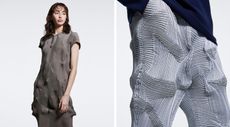 Get to know Issey Miyake’s innovative A-POC ABLE line as it arrives in the UK
Get to know Issey Miyake’s innovative A-POC ABLE line as it arrives in the UKAs A-POC ABLE Issey Miyake launches in London this week, designer Yoshiyuki Miyamae gives Wallpaper* the lowdown on the experimental Issey Miyake offshoot
By Jack Moss Published
-
 Eurovision unveils its 2024 stage, designed by Beyoncé's Renaissance Tour creatives
Eurovision unveils its 2024 stage, designed by Beyoncé's Renaissance Tour creativesThis year's stage design aims to bring the audience into the performance more than ever before.
By Charlotte Gunn Published
-
 Ikea meets Japan in this new pattern-filled collection
Ikea meets Japan in this new pattern-filled collectionNew Ikea Sötrönn collection by Japanese artist Hiroko Takahashi brings Japan and Scandinavia together in a pattern-filled, joyful range for the home
By Rosa Bertoli Published
-
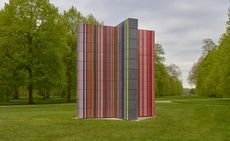 Gerhard Richter unveils new sculpture at Serpentine South
Gerhard Richter unveils new sculpture at Serpentine SouthGerhard Richter revisits themes of pattern and repetition in ‘Strip-Tower’ at London’s Serpentine South
By Hannah Silver Published
-
 Peter Blake’s sculptures spark joy at Waddington Custot in London
Peter Blake’s sculptures spark joy at Waddington Custot in London‘Peter Blake: Sculpture and Other Matters’, at London's Waddington Custot, spans six decades of the artist's career
By Hannah Silver Published
-
 Step into Yoko Ono’s immersive world at Tate Modern
Step into Yoko Ono’s immersive world at Tate Modern‘Yoko Ono: Music of the Mind’ spans the artist and activist's work from the 1950s to the present day
By Hannah Silver Published
-
 Oozing, squidgy, erupting forms come alive at Hayward Gallery
Oozing, squidgy, erupting forms come alive at Hayward Gallery‘When Forms Come Alive: Sixty Years of Restless Sculpture’ at Hayward Gallery, London, is a group show full of twists and turns
By Hannah Silver Published
-
 Frieze London 2023: what to see and do
Frieze London 2023: what to see and doEverything you want to see at Frieze London 2023 and around the city in our frequently updated guide
By Hannah Silver Last updated
-
 Tate Modern announces The Infinities Commission for rising contemporary artists
Tate Modern announces The Infinities Commission for rising contemporary artistsTate Modern’s new Infinities Commission will support experimental work from around the world
By Tianna Williams Published
-
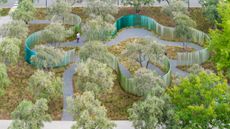 New glass sculpture creates a verdant wonderland at Apple’s Cupertino HQ
New glass sculpture creates a verdant wonderland at Apple’s Cupertino HQ‘Mirage’ at Apple Park is the work of Zeller & Moye and artist Katie Paterson, a shimmering array of glass columns that snakes through the grounds of the company’s monumental HQ
By Jonathan Bell Published
-
 Man Ray’s sculptures go on show in New York
Man Ray’s sculptures go on show in New York‘Man Ray: Other Objects’ opens at Luxembourg + Co, New York, revealing their author’s ‘artistic revolution’
By Hannah Silver Published